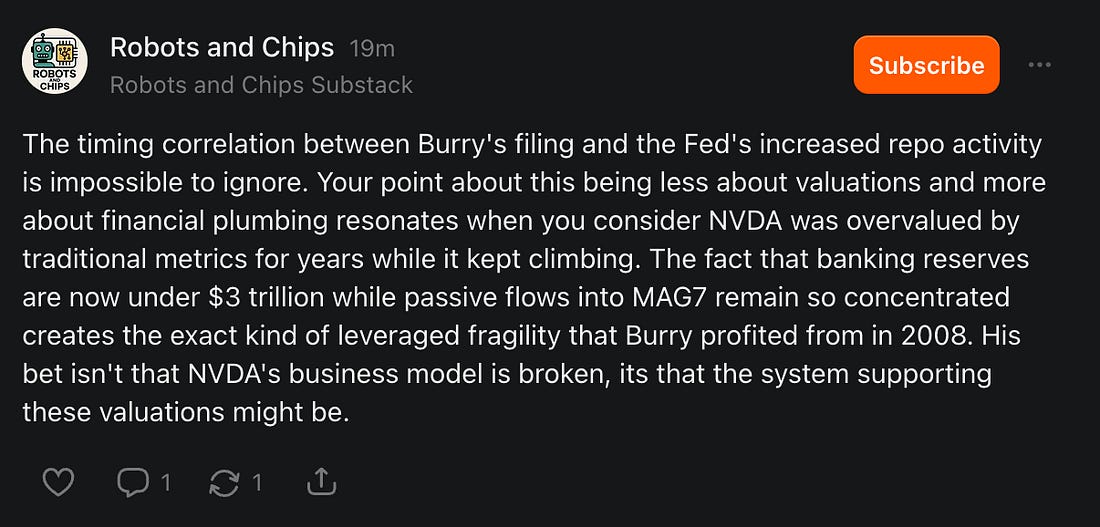More on Michael Burry and A Trip into the Red ZoneBurry's bet can't just be against NVIDIA. It has to be a bet against the system itself.Good morning: Welcome to the Red Zone of the S&P 500. As I’ve noted, it’s a little unusual for the reading to experience a move like this… while the MAG 7 remains above key moving averages. But that is - I believe - a testament to the incredible crowding, leverage, and ongoing pressure in just a few names. In addition, it’s worth noting that the signal shift in March 2023 provided no warning about regional banks and was explicitly linked to the banks for the first week. Right now, it’s easy to sit here and look at the plumbing of the financial system and assign blame. Recall that the signal switch happened just a few days before the implosion of Silicon Valley Bank in March 2023… And last year, it happened a few trading days before the Nikkei had its worst day since 1987. Today… we wake up, a good few days into the chop of this reading and then confirmation, and South Korea’s stock market has taken a nice punch, and the Japanese markets are under pressure. I have been beating this drum for a solid year. We’ve ignored the conditions in Japan. SoftBank shares just got slammed again… The markets keep rambling about AI exposure and valuations… but the reality is that SoftBank’s finances are a mess… And they’re a pseudo-Too Big to Fail company that the U.S. has been artificially propping up this year… This all comes on the heels of Michael Burry launching a massive blitz against Palantir (PLTR) and NVIDIA (NVDA). Burry has a $1 billion bet against the companies, prompting an incredible response from PLTR CEO Alex Karp that seemed to prove Burry’s point… CNBC rolled out this headline yesterday that again seems to miss the point… As I noted yesterday, Burry’s bet against “valuations” seems too elementary… This massive short is coming at a time that the financial plumbing is a mess and we’ve been privy to the never-ending liquidity expansion that has helped fuel these asset bubbles… After I finished publishing my article last night, a reader sent this response. Robots and Chips notes that the timing between Burry’s filing and the Fed’s recent interventions is hard to ignore. As I said, this feels like a bet against the plumbing of the system that enabled the valuations… Meaning “valuations” could be a code word for the fact that once a crack in the foundation comes in the financial markets, the valuations can’t withstand. Burry made his 2008 fortune - not when housing prices dropped - but when there was no financial engineering and excuses left to support the leverage infrastructure around the crumbling ecosystem. As this author writes: “His bet isn’t that NVDA’s business model is broken. It’s that the system supporting these valuations might be.” Those words comprise the sentence I’ve been looking to articulate for a month… So, thank you to Robots and Chips. What is Burry up against? Not NVIDIA. Not Palantir. Not Alex Karp… He’s in a showdown with the Standing Repo Facility. This is the Fed’s permanent liquidity fuse box. Yes… permanent… It’s the never-ending promise that no collateral will go unfunded… The idea that Treasury and agency paper can always be turned into cash overnight at a fixed rate. That means whenever funding cracks appear, the SRF instantly restores liquidity… It’s not through QE-style balance-sheet expansion, but through temporary collateral monetization. Functionally, though, it’s shadow QE. It guarantees that Treasuries can always be converted to cash overnight, effectively preventing a repeat of the 2019 repo crisis. But this backstop also breeds complacency. As banking reserves sink below $3 trillion and passive inflows stay jammed into the MAG7, each dollar of liquidity now carries more leverage and less cushion. Burry… if betting against NVIDIA against PLTR… has to bet against the system itself… His bet must include the idea that the SRF can’t absorb infinite stress… And that at some point, the cost of maintaining “orderly markets” outweighs the Fed’s tolerance for inflation and optics. If that confidence cracks, liquidity evaporates first, then valuations second. In 2008, Burry shorted mortgage collateral. In 2025, he’d better be shorting collateral confidence itself — the faith that the Fed’s repo machine can keep the system from choking on its own leverage. Let’s get into the pre-market updates… Continue reading this post for free in the Substack app |
Subscribe to:
Post Comments (Atom)





0 Response to "More on Michael Burry and A Trip into the Red Zone"
Post a Comment